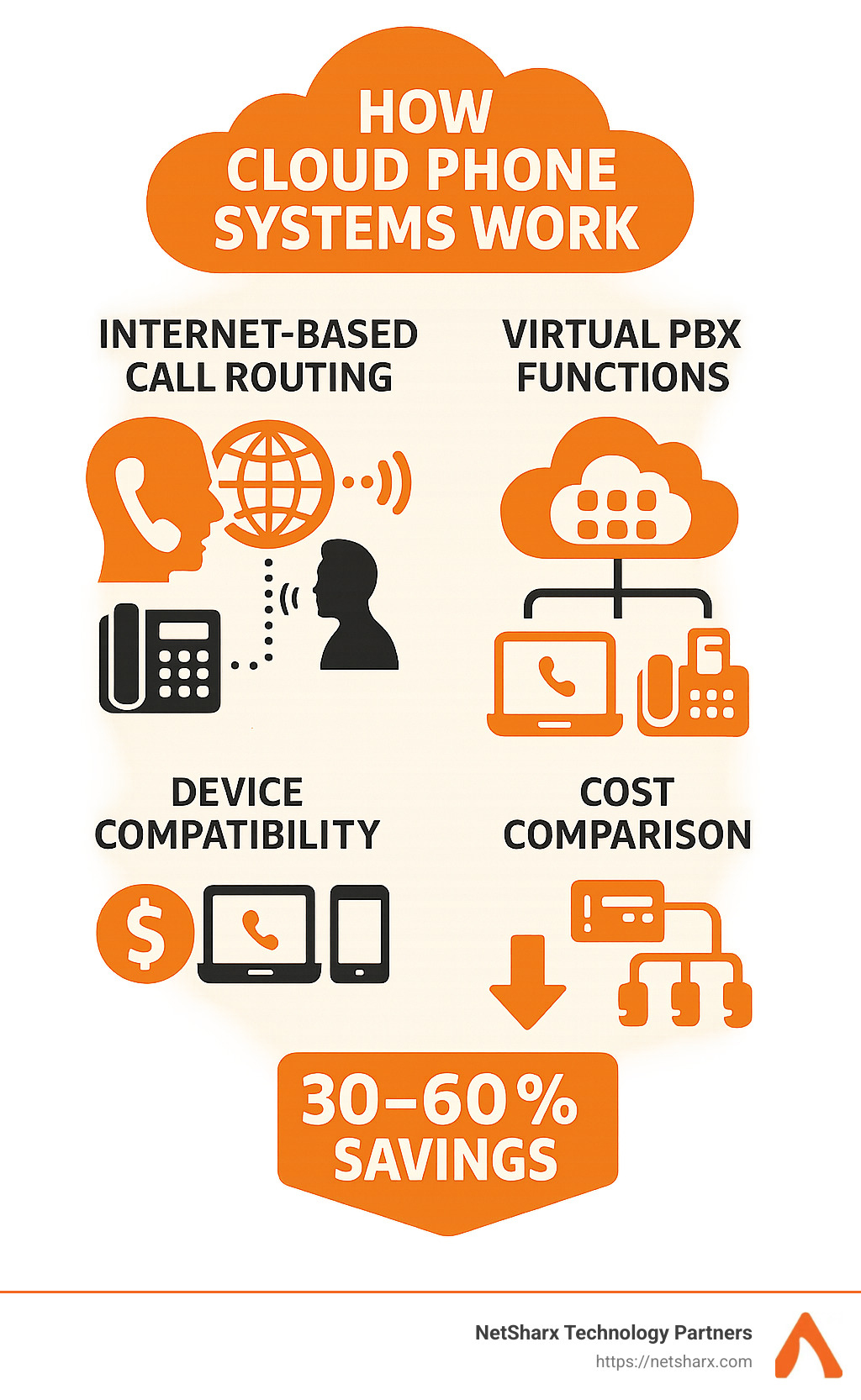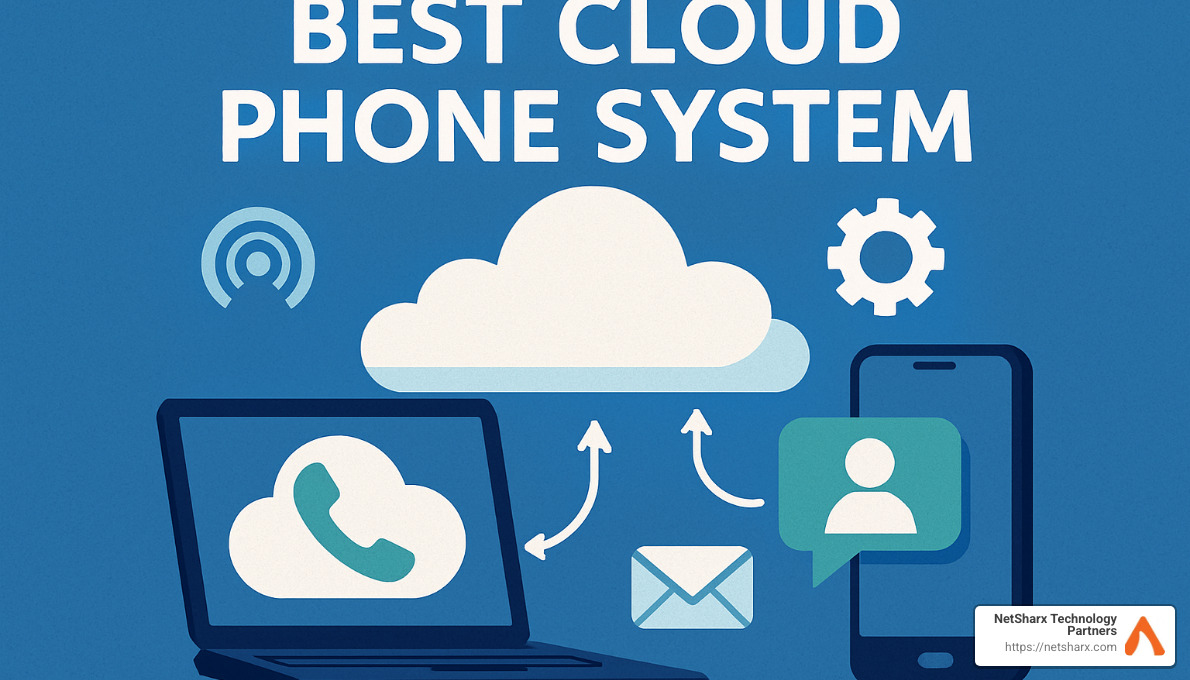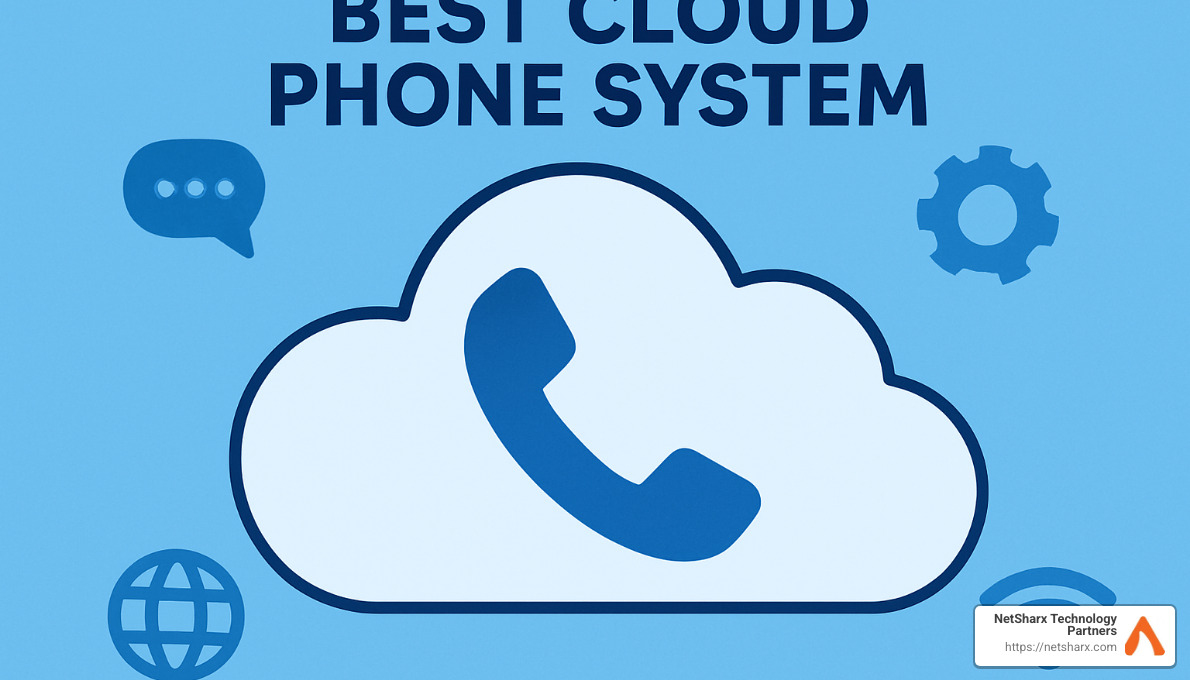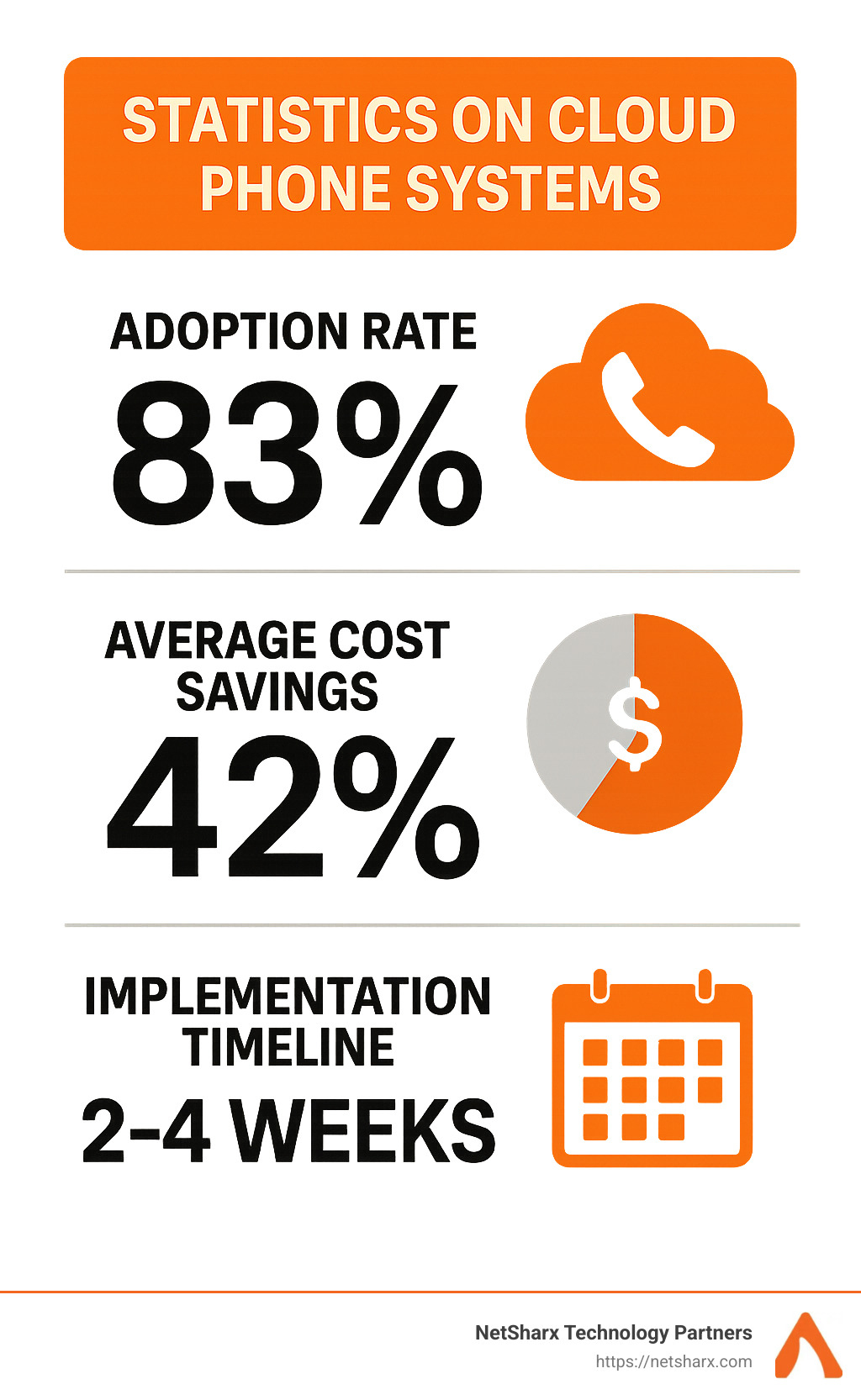Best Cloud Phone System: 5 Powerful Picks for Success 2025
Finding Communication Excellence in the Digital Age
| Best Cloud Phone Systems of 2025 |
|---|
| 1. AI-Powered UCaaS – Best for AI-powered unified communications |
| 2. Video-First Platforms – Best for video-first collaboration |
| 3. Small Business Solutions – Best for small business value and support |
| 4. AI Transcription Systems – Best for AI transcription and insights |
| 5. Global Calling Solutions – Best for international calling coverage |
Has your business outgrown its traditional phone system? You’re standing at the same crossroads where thousands of organizations have found themselves in recent years. The good news? The path forward is clearer than ever.
I’ve watched countless businesses transform their communication capabilities by adopting the best cloud phone system for their needs. As organizations accept digital change, those clunky desk phones and expensive PBX hardware are rapidly becoming relics of the past.
Think of a cloud phone system (also called hosted PBX or VoIP) as your traditional phone service reimagined for the internet age. Instead of copper wires and physical switchboards, your calls travel securely through the internet, opening up possibilities that were simply unimaginable with legacy systems.
The benefits are too significant to ignore. Most businesses see cost savings of 30-60% when they make the switch. Need to add new lines for seasonal staff or a growing team? With cloud systems, you can scale up or down in minutes without ordering hardware or scheduling technician visits.
For today’s hybrid workplaces, the flexibility is game-changing. Your team can make and receive calls from their smartphones, laptops, or desk phones – wherever they happen to be working. No more missing important client calls while away from the office.
The technology has matured beautifully, too. Modern cloud phone systems offer AI transcription that captures every conversation detail, powerful analytics to improve customer service, and seamless connections to the tools you already use like Salesforce, Microsoft Teams, or Google Workspace.
The best part? You don’t need to be a tech wizard to get started. Most systems can be set up in under an hour, and they only require about 100 kbps of bandwidth per line – less than what you need to stream music.
I’m Ryan Carter, founder and CEO of NetSharx Technology Partners. After helping hundreds of organizations find their perfect communications solution (and watching them cut technology costs by 30% or more in the process), I’ve developed a keen eye for matching businesses with the best cloud phone system for their unique needs. Let me walk you through the top options for 2025 and help you make a choice you won’t regret.
Related content about best cloud phone system:
– business hosted pbx
– hosted pbx phone
– pbx and voip
What Makes the Best Cloud Phone System in 2025?
Finding the best cloud phone system in 2025 means looking beyond basic call handling. Today’s solutions are comprehensive communication hubs that bring together voice, video, messaging, and team collaboration—all improved by artificial intelligence.
Did you know that roughly 25% of employees have thought about changing jobs because they dislike their workplace software? This eye-opening stat from G2’s State of Software Happiness Report shows just how important it is to choose technology your team will actually enjoy using.
When we help clients at NetSharx Technology Partners find their ideal communication solution, we focus on nine key factors that separate good systems from truly great ones:
AI automation capabilities have become game-changers, with features like real-time call transcription and sentiment analysis that transform conversations into actionable intelligence. The best cloud phone systems now serve as virtual assistants, not just calling platforms.
Integration ecosystem strength determines how well your phone system plays with other business tools. The leading solutions offer 300+ pre-built connections to CRMs, help desks, and productivity apps you already use.
Security & compliance certifications (SOC 2, HIPAA, GDPR) ensure your conversations remain private and meet industry regulations—absolutely essential for healthcare, finance, and other regulated industries.
Global coverage options let you maintain local presence with virtual phone numbers in countries where you do business, creating a professional image without physical offices.
Pricing transparency helps avoid surprise bills. The best cloud phone system providers offer clear, predictable pricing with minimal hidden fees.
Number portability capabilities determine how smoothly you can transfer your existing business numbers—a critical factor for maintaining business continuity.
Self-service administration through intuitive management portals empowers your team to make changes without calling support or waiting for IT.
Analytics depth provides visibility into call quality, usage patterns, and performance metrics that help optimize your communication strategy.
Uptime guarantees backed by service level agreements give you confidence in system reliability—look for providers offering the gold standard of 99.999% uptime.
As industry expert Reuben Yonatan, founder of GetVoIP, notes on Twitter: “The cloud phone system landscape has evolved dramatically. Today’s solutions aren’t just about cost savings—they’re about creating competitive advantages through better communication experiences.”
Key questions to identify the best cloud phone system
Before diving into specific providers, take a moment to clarify what you really need. Start by asking yourself what specific benefits you’re seeking compared to your current PBX. Are you primarily focused on reducing costs, enabling remote work, accessing advanced features, or perhaps all three?
Next, distinguish between must-have features and nice-to-haves. Do you absolutely need an auto-attendant and call recording? Would SMS capabilities and video conferencing significantly improve your operations?
Consider how your remote and hybrid teams will interact with the system. Will they mainly use mobile apps while on the go, desktop software at home, or traditional desk phones in the office? The best cloud phone system for your organization should accommodate your team’s actual work patterns.
Finally, think about your preferred budget model. One of the biggest financial advantages of cloud systems is the shift from capital expenses (large upfront investments in hardware) to operational expenses (predictable monthly subscriptions that scale with your needs).
Avoiding pitfalls when choosing the best cloud phone system
While cloud phone systems offer tremendous benefits, being aware of potential challenges will help you make a better decision:
Latency and call quality issues can arise if your internet connection isn’t stable. We often recommend implementing Quality of Service (QoS) settings on your network to prioritize voice traffic over other data.
Internet dependency means your phone system could go down if your internet connection fails. Look for providers offering mobile failover options and redundant connectivity paths.
Hidden fees for features like call recording storage, international calling, or toll-free minutes can quickly inflate your monthly bill beyond expectations.
Support limitations vary widely between providers. Some offer 24/7 assistance included in your subscription, while others provide limited hours or charge extra for priority help.
Migration complexities can catch businesses off-guard. Porting numbers and transitioning from legacy systems requires careful planning and expertise.
At NetSharx Technology Partners, we’ve guided countless businesses through these potential pitfalls. The cloud phone system landscape can be confusing to steer alone, which is why working with an experienced advisor often saves both money and headaches in the long run.
AI-Powered UCaaS Suite
When it comes to finding the absolute cream of the crop in cloud communications, AI-powered Unified Communications as a Service (UCaaS) platforms stand head and shoulders above the rest. These aren’t your grandpa’s phone systems—they represent the brilliant fusion of traditional voice calling with cutting-edge artificial intelligence.
Leading AI-powered UCaaS solutions have been recognized as Gartner Magic Quadrant Leaders for multiple consecutive years. Their platforms perfectly showcase what the best cloud phone systems can achieve when AI becomes fully integrated into everyday business conversations.
What makes these AI-powered systems so special? Imagine having a virtual assistant on every call, automatically capturing everything important without you lifting a finger. Real-time transcription turns spoken words into searchable text while smart sentiment analysis picks up on customer emotions (even when you might miss them). The ability to seamlessly bounce between voice, video, SMS, and team chat means your conversations flow naturally across channels without awkward transitions.
“We are saving 30% on our overall phone system costs,” shares Bala Nibhanupudi, CIO of First Bank, after moving to an AI-powered platform. Those savings aren’t unusual—we see similar results with many of our clients at NetSharx Technology Partners.
The mobile experience deserves special mention too. Full-featured apps for both iOS and Android mean your team stays connected whether they’re at their desk, working from home, or traveling between client meetings. With over 300 pre-built integrations to popular business tools, these systems don’t just handle calls—they improve your entire workflow by connecting with the CRMs, help desks, and productivity apps you already use.
And reliability? With 99.999% uptime SLAs (that’s less than 6 minutes of downtime per year), these systems keep your business talking when it matters most.
Why this category shines for the best cloud phone system seekers
What type of organization benefits most from AI-powered UCaaS? Simply put, those that want to work smarter, not harder.
If you’re looking to create a genuine multichannel workspace where your team can effortlessly switch between communication methods, these platforms deliver beautifully. The AI automation handles tedious tasks like taking notes and routing calls, freeing your people to focus on what humans do best—building relationships.
For data-driven organizations, the insights generated from communication patterns can be pure gold. Imagine understanding exactly why certain customer conversations lead to sales while others don’t, or identifying which team members excel at handling specific types of calls.
Enterprise security requirements? Covered. These systems typically offer comprehensive compliance with SOC 2, HIPAA, GDPR, and other regulatory standards your legal team will appreciate.
Matt Doughty from Waitrose puts it perfectly: “Because everyone is carrying their communication app with them on their main device, it’s much easier for our team to communicate with each other, even while they’re doing other tasks.” This natural integration into daily workflows represents the true power of these platforms.
The AI capabilities extend well beyond basic calls. Most platforms can analyze video meetings to flag action items, generate helpful summaries, and even provide real-time language translation across multiple languages—making global team collaboration remarkably smooth.
Fast setup & management
Remember the days when setting up a new phone system meant weeks of disruption and a small army of technicians? Those days are thankfully behind us with modern best cloud phone systems.
Today’s AI-powered platforms offer intuitive web portals that make system management refreshingly simple. Role-based access controls let you delegate specific management tasks without giving away the keys to the kingdom. Creating call flows—once the domain of specialized technicians—now uses drag-and-drop interfaces that anyone can master in minutes.
“With our new cloud system, the administrative tasks are much easier than other PBX systems I have used,” notes Vu Truong, IT Manager at Coursera. This simplicity translates directly to your bottom line by reducing the IT overhead needed to keep things running smoothly.
Perhaps most impressively, organizations can typically get a new cloud phone system up and running in hours—not the weeks or months traditional PBX installations demanded. This rapid deployment means your team spends less time adapting to new technology and more time using it to drive business results.
Video-First Collaboration Phone Platform
Remember when video calls were clunky add-ons to your phone system? Those days are gone. Today’s video-first cloud phone platforms flip the script by building robust phone functionality on top of powerful video conferencing tools, creating a seamless experience where voice and visual communication work in perfect harmony.
Leading video collaboration platforms stand out in this category, building on the household-name status that exploded during the pandemic. Rather than treating video as an afterthought, these providers designed their phone systems to complement their market-leading video platforms, creating a truly unified experience.
What makes these platforms shine is how naturally you can move between communication methods. Start with a quick voice call, then with one click, transition to a full video meeting when you need to show rather than tell. No awkward app switching or connection drops – just fluid conversation.
The core strengths of these systems include HD video meetings with interactive features like polling and breakout rooms, robust screen sharing for collaborative discussions, and extensive global calling coverage across 47+ countries. Both desktop and mobile clients offer consistent experiences, ensuring your team stays connected whether they’re at a desk or on the move.
How it delivers the best cloud phone system experience
What truly sets video-first platforms apart is their seamless integration of all communication channels. Voice-to-video transitions happen with a single click – perfect for when a complex topic needs visual explanation. The call flip capability lets you transfer active calls between devices without dropping the connection (imagine starting a call at your desk, then switching to your mobile as you head to a meeting).
Team chat integration means you can message colleagues before, during, or after calls, maintaining conversation context. And with calendar synchronization, joining scheduled calls happens directly from calendar invites – no more hunting for meeting links or dial-in numbers.
These capabilities transform how teams collaborate, especially for visual thinkers. Design teams can quickly share concepts, engineers can troubleshoot together while seeing the same screen, and sales teams can transition from quick check-ins to full product demos without missing a beat.
Pricing snapshot & use cases
The good news? Video-first cloud phone systems typically offer straightforward, predictable pricing. Most providers offer flat-rate US/Canada calling around $15 per user monthly, with expanded global coverage plans for about $20 per user. For occasional international calling to regions not included in your plan, pay-per-minute options keep costs manageable.
These platforms shine brightest in specific environments. Educational institutions leverage them for creating engaging hybrid learning experiences. Healthcare providers use them to streamline patient journeys from phone triage to video consultations. Field service teams rely on them to visually troubleshoot complex issues with remote experts, saving costly site visits.
Perhaps most impressive is how these systems serve creative agencies, where showing a concept often communicates more than lengthy explanations. The ability to sketch ideas in real-time while discussing them transforms creative collaboration.
The greatest advantage? Users only need to learn one interface for all their communication needs. This reduces training time, increases adoption rates, and ultimately delivers the cohesive experience that makes the best cloud phone system choices stand out from the crowd.
Budget-Friendly Small Business Cloud Phone
For small businesses, startups, and cost-conscious organizations, budget-friendly cloud phone systems offer essential features at accessible price points. These solutions provide professional communications capabilities without breaking the bank.
Leading small business solutions stand out in this category, offering what many consider the best cloud phone system for small businesses due to their balance of features, reliability, and affordability. The top platforms have handled over 2 billion calls on their networks and serve more than 100,000 customers globally.
When you’re running a small business, every dollar counts. That’s why these systems are designed with your budget in mind while still offering impressive functionality. You’ll find startup-friendly pricing with plans typically starting around $15-$20 per user monthly, and most providers offer free trial periods of 7-14 days so you can test before committing.
What I love about these budget options is that they don’t skimp on the essentials. You’ll still get a professional auto-receptionist to greet callers, business SMS capabilities to text from your company number, and mobile applications that transform your personal smartphone into your business phone. Plus, many offer a pay-as-you-grow model where you can add features as your needs evolve.
Stretching dollars with the best cloud phone system features
Small businesses can really maximize their investment in these systems with some smart strategies. First, eliminate hardware costs by using the devices you already own—your computers and smartphones can function as softphones with the right software.
Most plans include unlimited domestic calling, which means predictable monthly bills without surprise charges. If you’re marketing-savvy, take advantage of the SMS capabilities for text message campaigns and customer communications—a feature that used to require separate expensive software.
One of my favorite money-saving features is communication automation. Having voicemails automatically sent to email, setting up intelligent call routing rules, and using auto-attendants can reduce the need for additional staff while maintaining professional service.
Brandon Keller, Operations Manager at Triumph Motorcycles America Ltd., shared his experience: “We’re now seeing a 30% savings over our old system, which is real money.” On average, businesses save roughly $10 monthly per user by switching from traditional landlines to cloud-based systems—for a 10-person company, that’s $1,200 back in your pocket every year!
Quick checklist before you buy
Before you sign up for any best cloud phone system, take a moment to consider your specific needs. Think about your current team size and how many phone lines you’ll need in the next couple of years. Be honest about your calling volume—do you really need unlimited minutes, or would a more affordable metered plan work for your situation?
Consider how texting fits into your customer communication strategy and how quickly you expect to grow. And don’t forget about integration needs—the most value comes when your phone system talks to your other business tools like your CRM or helpdesk software.
“Budget-friendly” doesn’t mean “bare-bones.” Today’s affordable cloud phone systems offer surprisingly robust features that were once available only to enterprise companies. Whether you’re a solo entrepreneur or managing a growing team, there’s a solution that fits both your communication needs and your budget constraints.
At NetSharx Technology Partners, we’ve helped countless small businesses find the perfect balance between cost and functionality. The right system can make your small business sound big while keeping your technology spending small.
International Calling Powerhouse
When your business spans continents or your customers call from around the globe, you need more than just a standard phone system. You need an international communications powerhouse that makes calling Tokyo as simple as calling Toledo.
In this category, global calling solutions stand head and shoulders above the competition. The best platforms offer unlimited calling to up to 48 countries under a single predictable monthly fee – making them the best cloud phone system for organizations with serious global communication needs.
“We switched to a global calling solution last year and our international calling costs dropped by nearly 60%,” shares Maria Gonzalez, Operations Director at Global Trade Solutions. “Plus, our customers love being able to reach us on local numbers in their countries.”
The international calling heavyweights deliver features designed specifically for global businesses:
Unlimited calling packages to 40+ countries let you budget with confidence, eliminating surprise bills after long international calls. Multilingual auto-attendants greet your callers in their native language, creating an instantly personalized experience. With global toll-free options, you can establish a local presence in international markets without opening physical offices.
For businesses concerned about service interruptions, regional failover capabilities ensure your communications continue even during localized outages. And with comprehensive compliance frameworks covering GDPR, HIPAA, and region-specific regulations, you can communicate with confidence knowing you’re meeting legal requirements worldwide.
Why global teams see it as the best cloud phone system
Global organizations love these platforms because they solve real-world international business challenges. If your company maintains offices across multiple countries, these systems connect your teams with crystal-clear quality at a fraction of traditional calling costs.
Businesses serving international customers benefit from the ability to provide local numbers in dozens of countries. Your Frankfurt customers can call a German number while your Sydney clients dial an Australian one – all routing to your team wherever they’re located. This local presence dramatically improves answer rates and customer perception.
For multilingual organizations, live translation capabilities break down language barriers in real-time. And companies running “follow-the-sun” support models can seamlessly transfer calls between global teams as different regions start their workday.
Perhaps most valuable for IT leaders, these platforms provide detailed call quality metrics for international connections, helping you identify and resolve issues before they impact customer experience.
Cost and performance highlights
The financial benefits of specialized international calling platforms can be substantial. Most providers offer bundled international minutes included in your monthly subscription, eliminating the shocking per-minute rates of traditional carriers.
Per-second billing ensures you only pay for actual talk time, not rounded up to the nearest minute (which can save 20-30% on call costs). And with data centers strategically positioned worldwide, these systems deliver low-latency connections – typically under 150 milliseconds – for natural-feeling conversations without awkward delays.
For businesses bringing existing international numbers, these platforms support regional number portability, allowing you to transfer your current numbers to the cloud system. Most importantly, rates are typically 40-60% lower than traditional international calling costs.
“We’re a small company, but we do business in 12 countries,” explains James Chen, founder of Artisan Imports. “With our best cloud phone system, we can afford to maintain local numbers in every market we serve. Our customers appreciate that we’re just a local call away, even though our team is based in Chicago.”
For organizations with global ambitions but budget constraints, these international calling powerhouses deliver enterprise-grade global communications at surprisingly accessible price points.
Self-Managed Open Platform PBX
If you’re the type who likes to pop the hood and tinker with the engine, self-managed open platform PBX systems might be your perfect match. These solutions offer a refreshing alternative for tech-savvy organizations that crave maximum control while still enjoying cloud benefits.
Leading open-source platforms stand out in this category, providing an open-source core that you can deploy wherever you want—on your own hardware or in the cloud. This flexibility makes it particularly attractive if you have specific requirements or security concerns that keep you up at night.
What makes these platforms special? For starters, they’re built on open-source foundations with transparent code and active community support. You can choose between on-premises hardware or cloud hosting, depending on your comfort level and resources. Instead of the typical per-user fees that make CFOs wince as you grow, these systems typically charge per system rather than per extension.
Many include integrated website live chat capabilities that let you engage visitors directly. The built-in web-RTC video conferencing means your meeting participants won’t groan about downloading yet another app. And when you’re ready to level up, modular call center functionality lets you add sophisticated contact center capabilities without starting from scratch.
The cherry on top? Many of these platforms offer free tiers for small deployments—typically up to 10 users—making them perfect for startups with more technical know-how than budget.
Control freak’s guide to the best cloud phone system
Let’s be honest: some IT professionals like having their hands on the controls. If that’s you, self-managed platforms offer several compelling advantages.
With root access to the system, you get complete control over every configuration setting and security parameter. No more begging support to make changes—you’re in charge. You’ll also enjoy the freedom to choose SIP trunks from any provider, allowing you to shop around for the best rates and quality for different call destinations.
The custom integration capabilities through webhooks and APIs mean you can connect your phone system to virtually anything in your tech stack. And perhaps most importantly for growing organizations, cost predictability comes from avoiding those per-user pricing models that seem reasonable until your headcount doubles.
As one enthusiastic system administrator put it: “Open-source phone systems. What can’t they do? We have an on-prem version. It’s so versatile. Everyone, everywhere can use it.”
For organizations with technical talent on staff, these platforms can deliver the best cloud phone system experience by offering enterprise-grade features without the enterprise-grade price tag. It’s like getting a luxury car at compact car prices—if you’re willing to do some of the maintenance yourself.
Deployment essentials
Before you dive into self-managed cloud telephony, make sure you’ve got these bases covered:
You’ll need a properly sized virtual machine or cloud instance that can handle your expected call volume without breaking a sweat. Setting up appropriate firewall rules is crucial—your system needs to be accessible but not vulnerable. Proper SSL certificates ensure your communications remain encrypted and secure.
Don’t forget to develop a solid backup and high availability strategy to prevent those dreaded service disruptions that make everyone stare at you in the hallway. And carefully research SIP trunk provider selection, as the reliability and rates of these services will significantly impact your overall experience.
Yes, the initial setup requires more technical knowledge than fully hosted solutions. It’s not for everyone. But the long-term benefits—greater control, endless customization options, and potentially lower total cost of ownership—make it worth considering if you have the expertise in-house.
At NetSharx Technology Partners, we’ve helped numerous technically-inclined clients implement self-managed solutions when it made sense for their specific needs and capabilities. Sometimes the best cloud phone system is the one you can truly make your own.
Choosing the Best Cloud Phone System for Your Business
After exploring all these great options, you might be wondering: “So which cloud phone system is actually right for my company?” It’s a fair question! With so many excellent choices available, finding your perfect match requires looking at what matters most to your specific situation.
At NetSharx Technology Partners, we’ve helped countless businesses through this decision process. We typically use a decision matrix approach to compare options against what our clients truly need:
| Category | Cost | Features | Scalability | Setup Speed | Best For |
|---|---|---|---|---|---|
| AI-Powered UCaaS | $$$ | Extensive | Unlimited | Fast | Enterprises, mid-market |
| Video-First | $$ | Video-focused | Unlimited | Very fast | Remote teams, education |
| Budget-Friendly | $ | Essential+ | Flexible | Fast | SMBs, startups |
| International | $$$ | Global-focused | Unlimited | Medium | Multinational orgs |
| Self-Managed | $ | Customizable | Self-determined | Complex | Technical teams |
I recently spoke with Sara Tiffany, who runs a growing marketing agency. She told me: “The setup and configuration of our cloud phone system is a dream. It’s so easy to create new numbers, set up IVRs, and change people around to different teams if needed.” This kind of user-friendly experience can make all the difference in your day-to-day operations.
When making your decision, think beyond just today’s needs. The best cloud phone system for your business should have room to grow with you over the next 2-3 years without forcing you to switch platforms again. Consider how your team structure, customer base, and communication patterns might evolve during that time.
The final checklist to secure the best cloud phone system
Before you sign on the dotted line, take these practical steps to ensure a smooth transition:
-
Conduct a bandwidth test: Make sure your internet connection can handle your expected call volume (remember that 100 kbps per line minimum we mentioned earlier)
-
Review QoS settings: Your network should be able to prioritize voice traffic over other data to maintain call quality
-
Confirm device compatibility: Check that your existing phones, headsets, or other hardware will work with the new system (or budget for replacements if needed)
-
Develop a training plan: Even the most intuitive systems require some adjustment—prepare to help your team accept the new platform
The right system can directly impact your bottom line. Sara Kinsella, a sales operations manager at a software company, shared with me: “We have increased our quotas by 10% because of the data we’ve gathered from call tagging and analytics from our cloud phone system.” That’s the kind of tangible business result that makes the transition worthwhile.
Porting your existing numbers without downtime
One common concern I hear from clients is: “What happens to our phone numbers during the switch?” Good news—you can keep your existing business numbers when moving to a cloud system, but it requires some planning:
The process begins with a Letter of Authorization (LOA) where you formally approve the transfer. Expect the complete porting process to take about 2-4 weeks, depending on your current provider’s responsiveness. During this transition period, most best cloud phone system providers will give you temporary numbers to use, ensuring you never miss a call. Once the port completes, you can either retire these temporary numbers or keep them as additional lines.
Don’t forget to update your E911 information during the transition. This ensures emergency services can find your physical location if someone needs to call 911 from your business line.
Frequently Asked Questions about Cloud Phone Systems
What is a cloud phone system and how does it work?
When people ask me about best cloud phone systems, I always start with the basics. Think of a cloud phone system as your traditional office phone setup, but instead of bulky hardware and tangled wires, everything runs through the internet. These systems (sometimes called hosted PBX or VoIP phone systems) use Voice over Internet Protocol technology to turn your voice into digital data that travels over the web.
It’s actually pretty straightforward how it works. When you speak into your device, your voice gets converted into digital packets, these packets zoom through your internet connection to the provider’s data centers, and then they’re routed to whoever you’re calling – either through the traditional phone network or directly to another internet phone user.
The beauty of this approach? You only need a decent internet connection and something to talk into – your smartphone, computer, or a specialized VoIP desk phone. Gone are the days of maintaining expensive PBX hardware in a closet somewhere in your office!
How much does a cloud phone system cost per user?
Talking about costs always brings a smile to my face because this is where best cloud phone systems really shine compared to traditional setups. Most businesses can expect to pay between $15 and $50 per user each month, depending on what features you need.
Providers typically offer tiered pricing that looks something like this:
- Basic plans run about $15-20 monthly per user, giving you essentials like auto-attendants, voicemail, and unlimited calling within the US
- Standard plans bump up to $25-35 for added goodies like team messaging, video meetings, and more integration options
- Premium plans at $40-50 open up the full experience with advanced analytics, call recording, and international calling packages
Many of our clients at NetSharx Technology Partners save an additional 15-20% by paying annually instead of monthly. And here’s a money-saving tip – many providers waive setup fees if you ask nicely (or sometimes even if you don’t!).
Just remember to factor in any IP phones you might want to purchase and add-ons like toll-free numbers. But even with these extras, businesses typically pocket about $10 in savings per user each month compared to traditional phone systems. For a 25-person company, that’s $3,000 a year back in your budget!
What are the potential drawbacks of cloud phone systems?
I believe in honest conversations about technology, so let’s talk about some challenges you might face with best cloud phone systems. While they’re amazing solutions for most businesses, they’re not without a few considerations.
First and foremost, your phone system becomes dependent on your internet connection. If your internet goes down, so might your phones – though good providers offer workarounds like automatic call forwarding to mobile devices when this happens.
Call quality is another consideration that depends on your internet connection’s stability. If your network experiences congestion, high latency, or packet loss, your calls might sound choppy or delayed. This is why we always recommend running a bandwidth test before switching.
Security is something to take seriously too. You’ll want a provider with strong encryption and relevant compliance certifications for your industry. The good news is that reputable cloud phone providers often have security measures that exceed what most businesses could implement on their own.
There might be some technical adjustments needed too – like upgrading to a router that can prioritize voice traffic (called QoS or Quality of Service). And don’t forget about the human element – some team members might need a little time to get comfortable with new interfaces and features.
As Anton Zillberberg, one of our business owner clients, shared with me recently: “Our cloud phone system was the only one that allowed us the flexibility to customize our customer service needs based on our business practices.” This highlights something important – the right system should adapt to how you work, not force you to change your processes to fit the technology.
At NetSharx Technology Partners, we’ve helped hundreds of businesses steer these considerations to find their perfect cloud communications fit. The right provider will have solutions for each of these potential challenges, turning them into minor speedbumps rather than roadblocks.
Conclusion
The shift to cloud phone systems represents one of the most significant changes in business communications of the past decade. By eliminating expensive hardware, reducing maintenance costs, and enabling remote work capabilities, the best cloud phone systems deliver both immediate cost savings and long-term strategic advantages.
When we look at the big picture, the benefits are crystal clear. Most businesses reduce their communications costs by 30-60% compared to traditional PBX systems. That’s real money going back into your business, whether you’re a startup watching every penny or an enterprise looking to optimize spending.
But it’s not just about saving money today. The flexibility of cloud systems means you can scale up during busy seasons or expansion, then scale back if needed—all without wasting resources on unused hardware. Your team can work from anywhere, on any device, maintaining professional communications whether they’re in the office, at home, or on the road.
I’ve seen how the advanced features in today’s systems transform communications from a basic utility into a genuine competitive advantage. When your sales team can instantly access call recordings and transcripts, or your support staff can see a customer’s entire communication history before answering a call, you’re operating at a different level than competitors stuck with basic phone service.
Lauren Panken, an operations manager who made the switch, put it perfectly: “Instead of digging through multiple systems trying to find clues, the right information is already there, helping us anticipate an issue before the customer even mentions it.” That kind of insight is priceless.
The best cloud phone systems don’t exist in isolation—they connect seamlessly with your CRM, help desk, and productivity tools to create unified workflows that eliminate duplicate work and reduce human error. This integration capability might not be the flashiest feature, but it’s often where the biggest productivity gains happen.
Here at NetSharx Technology Partners, we specialize in helping businesses steer the complex landscape of cloud communications. Our approach is different—we’re completely agnostic when it comes to providers. This means we can honestly recommend the perfect solution for your unique requirements without pushing you toward a particular vendor. Whether that’s an AI-powered UCaaS platform, a video-first collaboration system, or a budget-friendly option for your growing business, we’ll help you find the right fit.
The world of business communications has transformed, and the opportunities for improvement are substantial. Ready to explore how the best cloud phone system can transform your business communications? Contact our team for a free consultation and find how we can help you dial up success in the digital age.









